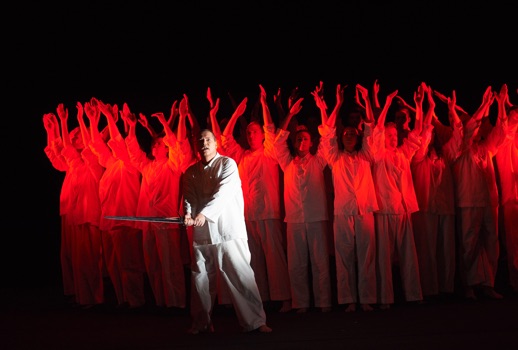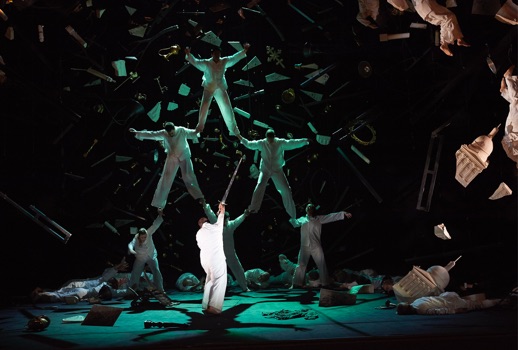
First seen in 2005, Siegfried returned as part of the Ring Cycle which opened the Four Seasons Centre the following year and makes a welcome return as a stand-alone production this season. (Last season saw a revival of Atom Egoyan’s Die Walküre and next season will see the return of Tim Albery’s Götterdämmerung. Alas, Michael Levine’s imaginative Das Rheingold has not been invited to the reunion). With a stronger cast than was seen and heard last time around, this is one of those rare revivals which has improved in its third outing.
Girard’s production is highly conceptual, framing the entire opera as a journey in Siegfried’s mind. The opera is presented a dream. All the characters wear white “pyjamas” with the exception of Brünnhilde who still wears her black Victorian dress in which she was put to sleep in Die Walküre. Siegfried sits on a giant tree stump (presumably the same one from which the sword Nothung was extracted) while a “tree” figuratively grows out of his head. The black-and-white set design provides an ideal canvass for David Finn’s evocative lighting.
Suspended in the tree’s branches are bits and pieces of the sets from the previous two operas of the cycle as well as dead bodies of the fallen. There are six acrobats sitting in the tree who come to life sporadically. Most prominent are a man and woman who represent Siegfried’s parents and respond when they are mentioned by the players below. Siegfried sits on the stump when the curtain rises and, when he’s supposed to leave the stage, returns to his spot. Mime and the bear are lowered from the top of the tree while Der Wanderer emerges from the tree trunk.
Speaking of the bear, this is the production’s most curious element. It is portrayed by a mime (George Molnar) in a bear suit. But he’s also dressed (deliberately ill-fittingly) with the same pyjamas as the rest of the cast. After Siegfried tells the bear to be off, he sticks around… for the entire act. (The Wanderer also sticks around after his scene, wandering across the set and eventually taking a seat leaning against the tree stump).
The concept is interesting but the execution is bewildering. No attempt is made to make the bear a menacing figure and instead he feebly hobbles around the stage observing the action. When I first saw the bear in the production’s premiere, I found him puzzling. This time, I found him tedious.
A hole in the ground serves as a forge and, for the Forging Scene, human hands appear from it bathed in red light. Like everything else in the act, the forging of the sword is giving a dreamy presentation. This act is successful in setting up the concept for the rest of the production but is less successful in portraying the drama. The first act of Siegfried features some of the most energetic and muscular music in the entire cycle—almost none of which is portrayed in the staging.

The coup de theatre is the presentation of the dragon. The six acrobats emerge from the stage floor and form a human pyramid. The dragon is not some giant prop but rather made up of people in Siegfried’s mind. As Fafner delivers his final lines, the pyramid slowly collapses and the top figure falls into Siegfried’s arms.
While the second act set is a visual explosion, the third act is completely bare. With the set immaculately dark, the only decorative feature is a pile of human bodies at the centre of the stage. The characters seem to float through space. When Siegfried approaches Brünnhilde’s rock, the bodies rise and form a circle, with red light flickering on their white costumes.
Brünnhilde lies at the centre of the circle, covered in a black drape. In the final duet, Siegfried and Brünnhilde never touch. They come close a few times but she pulls back. Only as the ecstatic closing measure of the opera ring out does the pair approach each other for an embrace. The dream ends as they kiss and the last chord strikes, setting the stage for the hero to go out into the real word.
Musically, this was a thrilling remount. Chief among the stars were the COC Orchestra under the direction of music director, Johannes Debus. Conducting his first Siegfried, Debus paced the drama expertly, capturing the mercurial qualities of the score while also evoking the grander moments with expansive phrasing. The orchestra responded splendidly, with the many competing leitmotivs vividly coming to life.
There was a brash confidence to the way tenor Stefan Vinke took on Siegfried’s punishing music. Most tenors skate over the difficult virtuoso opening line but he attacked it with gusto, culminating in a sustained (though too long) high C. While he didn’t offer much by way of beautiful or varied singing (the few times he did made one wish for more), he displayed solid power and endless stamina.

The tone lacked brilliance but had pleasing warmth and he thrived at the top of his voice, joining soprano Christine Goerke for a thrilling, sustained high C at the end. As an actor, Vinke was convincingly boisterous and portrayed the titular hero as a careless, if still likeable, jock. At curtain, he was given an immediate solo bow and received one of the loudest ovations I’ve heard in the Four Seasons Centre.
Goerke poured out a flood of warm tone on her opening “Heil dir, Sonne” but took a few minutes to warm up, her voice sounding unfocused at first. She conquered all of the high lying passages and her singing grew with intensity as the scene progressed. This was a very movingly portrayed Brünnhilde and I anxiously await her return in Götterdämmerung next year.
When I heard Alan Held as Kurwenal a couple of years ago, I thought that I’d like to hear his Wotan and he did not disappoint, pouring out reams of bronzed, ringing tone as Der Wanderer. The extreme ends of his voice lost colour and power but this was an imposing performance, both vocally and physically.
As Mime, Wolfgang Albinger-Sperrhacke sang with ideal German declamation and delivered precision (and often amusing) acting, while Chrisopher Purves powerfully embodied Alberich’s desperation and desire. It was a pleasure to listen to contralto Meredith Arwady dig into Erda’s low notes while soprano Jaqueline Woodley sang with an appropriately silvery tone as the Forest Bird. The only consistent cast member of this production’s three incarnations, bass Philip Enns once again growled impressively as Fafner.
In the final verdict, Girard’s vision of the story as a dream in Siegfried’s mind works if not taken too strictly. Taken literally, the concept can be confounding (Can Alberich exist in Siegfried’s mind considering the two never meet? Is that why he wears a dark overcoat over his pyjamas when no one else does?). However, taken as a loose framework for Siegfried’s journey of self-discovery, it works in a thought-provoking manner, satisfyingly developing along its long arc.
Photos: Michael Cooper





Comments